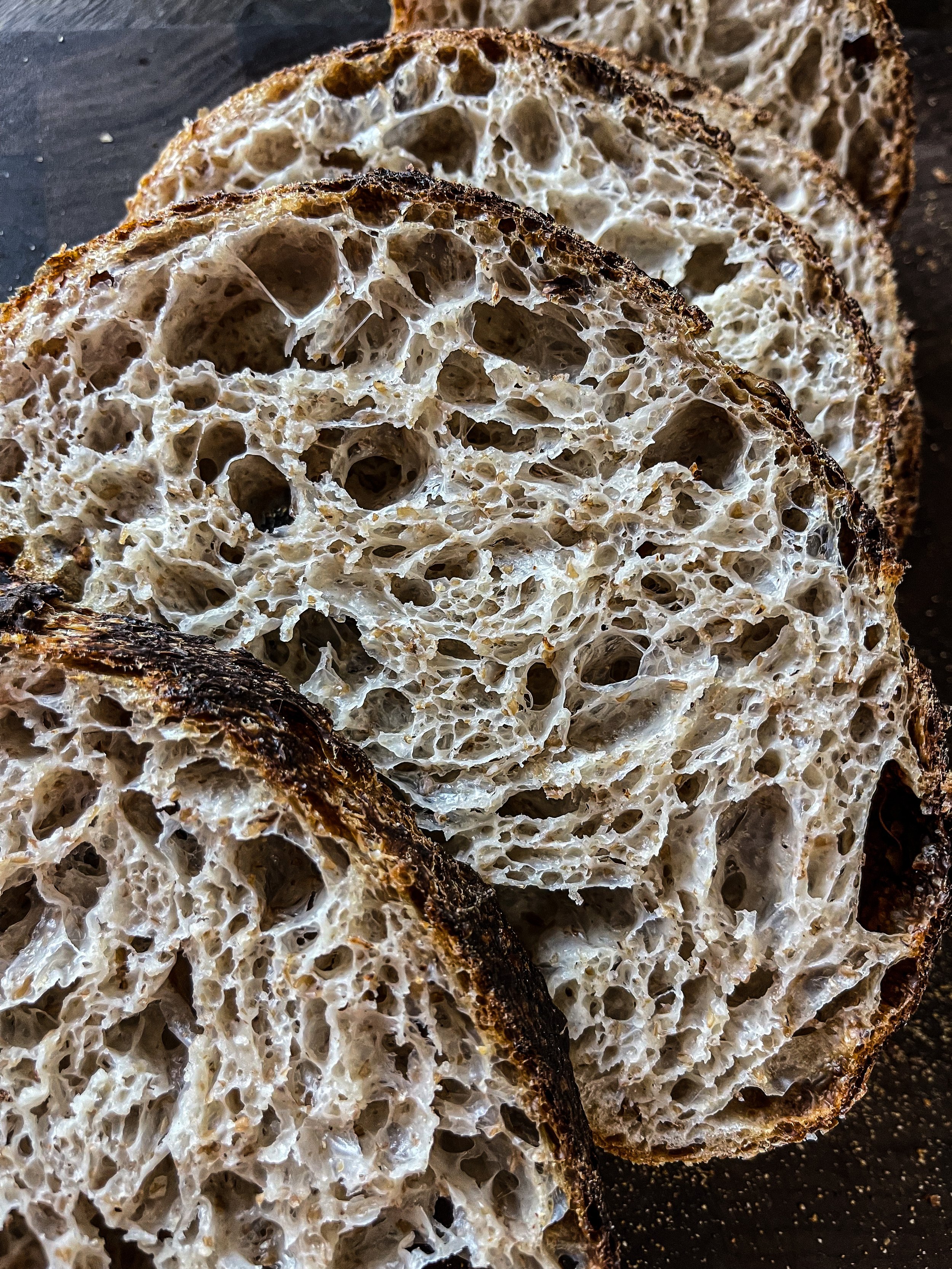50% whole meal open crumb
So far I’ve made a few loaves with higher percent of whole grain, and with each I’ve learned valuable lessons. Yes, you can achieve open crumb with 50% or higher whole grain if you follow few simple steps and have an understanding of the things you do and why you do them.
For this type of sourdough we are not looking for big and irregular alveoli but simply for well fermented crumb that is soft, which also represents openness. Whole grain bread doesn’t have to be dense. Usually, the more the whole grain, the denser the crumb, but not necessarily if optimal level of fermentation is applied. Even if you push its limits and sacrifice a bigger oven spring.
Know your whole grain flour well
One of the important things is to be very familiar with your whole grain flour and how it behaves during fermentation. How well it can handle longer fermentation, is the key to that softer crumb. Because as we know, the whole wheat flours supposed to ferment faster. But not all of them. My experience and observations are that, for example, whole meal flour takes longer to ferment, and that is because it’s with higher protein but also because the whole grain is there, even the bran. And that plays a big part in the rate of fermentation.
It takes the enzymes much longer to convert the starches into simple sugars because of the whole grain. Whole meal is a coarse flour with the bran in it and that also affects the rate of fermentation, the bran interferes with gluten development. That’s why many bakers prefer to sift it out.
Because of the coarseness of the flour and the bran, I chose to do a very long autolyse which really helps with softening the grain and the bran. That prevents them from tearing the gluten.
With the grain softened it’s much easier for the enzymes to do their job.
Applying optimal hydration for this type of flour is also very important, for the same reasons. It’s a flour with high protein and whole grain and lots of water is needed to boost enzymatic activity. The brand of whole meal flour I used is also more elastic than extensible and high hydration really helped by introducing more extensibility which greatly helped with opening up the crumb.
step by step method
ingredients:
175g bread flour(12% protein)
175g whole meal flour(Petra 9)
325.5g water(93% hydration)
70g starter
7g salt
1. At night, before bed, mix the flours and water together and do overnight autolyse. Mine was 14h long at 67-68F. It’s very important to make sure that an autolyse of that length is done at cool temperatures which slows down enzymatic activity. You will wake up to meet a very well hydrated dough and fully developed gluten. You’ll notice how soften the grain is and how smooth the dough is.
2. Add the starter to the dough and mix gently. I mixed for only a minute just to incorporate it. The dough was so easy to work with, very supple. The starter that I used was 13h old, kept at 74F, fed with 1:6:6 ratio(10:60:60) In my upcoming book, you’ll find a complete description of my way of starter maintenance. A strong and vigorous starter is needed for a good quality fermentation.
3. Thirty minutes later, add the salt and mix gently to incorporate.
4. Do one lamination
5. Transfer the dough to a bulking dish and let it bulk ferment. Perform coil folds as needed. I did 5 coil folds separated by 45min., my dough was beautifully extensible with that length of autolyse and 93% hydration. You want to make sure that you build a strong dough structure, so observe the dough and see how it’s developing. Let the dough ferment well! My total bulk fermentation was 10h at 72-75F. Up until lamination, I kept the dough at 72F and then moved it inside my proofer at 74-75F.
6. The dough should be big and puffy, more than doubled in size.
7. Shape the dough
8. Retard the shaped dough in the fridge. My proof time was 17h at 38-40F.
9. Bake the bread. I baked mine in a cast iron vessel, the first 20min with the lid on at 500F and then removed the lid, lowered the temperature and baked for another 20min at 430F. Since the hydration is very high and the nature of the flour, I left the baked loaf inside with the oven turned off to make sure that the water is completely baked through and the crumb is dry. I didn’t do that for my other whole grain loaves and noticed that the crumb was a little moist and sticky. So keeping it longer in the hot oven(turned off) helped a lot.




